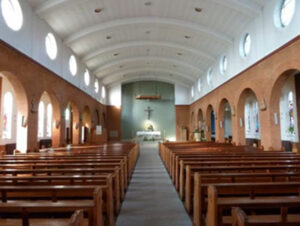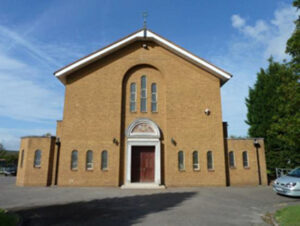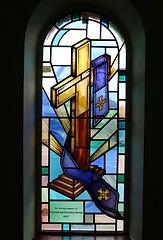History of The Parish of Corpus Christi
In 1938 Mass was first said in Collier Row at the British Legion Hall by the late Canon Martin Horkan, then an assistant priest at St Edward’s, Romford. During the war the hall was requisitioned by the army and so Mass was celebrated from that time at the Bell and Gate Public House.
In 1952 Bishop Beck gave permission to build the Parish Hall in Lowshoe Lane and Mass was said there for the first time on 10 May 1953. The first baptism took place on 12 May 1953. The Hall served as church, school and social centre.
Bishop Beck formally blessed and opened the Parish Hall on 14 December 1953. Collier Row was erected as an independent parish the following day and Father Michael Hopkins appointed as the first parish priest. He was responsible for building the presbytery, school and church.
The Church
The foundation stone, which can be seen on the left-hand side of the Sanctuary, was laid on 6 December 1964 by the then Bishop of Brentwood, the Right Reverend Bernard Patrick Wall, DD. The church was opened on 28 November 1965.
The church and parish are dedicated to the mystery of the Eucharist: Corpus Christi, the Body of Christ. The Titular Feast is now celebrated on the Sunday following Trinity Sunday: the Solemnity of the Most Holy Body and Blood of Christ.
The design of the church is a free modern interpretation of Italian Romanesque architecture. The nave and sanctuary form the main body of the church and are flanked by brick colonnades, each supporting seven brick arches and are lighted at high level with bull’s eye windows, one window above each arch. The ceiling is a segmental arched vault with encased beams dividing the ceiling into panels, each beam spanning between a pair of brick columns, providing a clear span over the Nave and Sanctuary of 35 feet.
The Nave, which has a seating capacity of 450, is 70 feet long and the Sanctuary is 26 feet. Beyond this length the Reredos wall of the Sanctuary is recessed a further 4.5 feet to create a shallow Apse. The Sanctuary and Narthex are paved in terrazzo. The Nave colonnades open out into the side Aisles which have flat ceilings with arched openings and pilasters corresponding to each brick column.
The Chapel of Our Lady is situated adjacent to the Sanctuary and Nave and can be seen through two of the brick arches. The Chapel measures 28 feet by 15 feet, has a seating capacity of thirty and is lighted with four semi-circular headed windows. The spacious Narthex is linked to a secondary Porch with wheelchair access. An open glazed screen gives a fine view of the interior of the church from the Narthex. The facing bricks used for the internal walls are hand-made light red bricks. Externally the church is faced with golden brown facing bricks and the roof covered with sand faced pantiles. A striking feature of the façade is the central doorway with a pair of polished hardwood panelled doors set in a stone surround with a mosaic panel in the pediment, all set in a tall arched recess in the gable wall.
The church was consecrated by Bishop Patrick Casey on 6 December 1979, just fifteen years after the laying of the foundation stone.
A Tour of the Interior
The Baptistery is located close to the entrance to the church; it is a constant reminder of the Sacrament through which we enter the Church community and become a member of God’s family. On entering the church, recalling their own baptism, Catholics dip their right hands in the water and make the Sign of the Cross. The Font, made of Ancaster stone, is octagonal in shape following an ancient custom of the Church. Its eight sides represent the seven days of the first Creation story in the book of Genesis (the six days of creative activity and the seventh day on which God rested) and the eighth side representing the day of re-creation – the day of the resurrection of Christ.
At the Font we are re-created as children of God; we die with Christ and rise with him to new life. The stone base is made of polished German limestone. The copper bowl was commissioned for our parish from the artist and coppersmith Sian Evans. It includes wave-like patterns symbolising the waters of baptism and three ancient Christian symbols:
– the ichthus (Greek for ‘fish’) a brief statement of belief in the form of an acronym which translates: “Jesus Christ, God’s Son, Saviour”;
– the Chi-Rho – the first two Greek letters (X and P) of the word ‘Christ’;
– the Celtic Cross – the Sun with a cross superimposed over it.

Standing nearby throughout the year is the great Easter Candle – the sign of the Risen Christ in whose light and life the baptised share. During the Easter season, according to an ancient tradition, the candle stands close to the ambo.
To the left of the entrance is the staircase leading to the Choir and Organ Gallery. The organ was built in 1983 by Schumacher of Belgium.
Beyond the staircase is the door leading to the Chapel of Reconciliation. This room, which was originally the Baptistery, was remodelled to enable the Sacrament of Forgiveness and Reconciliation to be celebrated in accordance with the demands of the restored rite. A simple curtain provides anonymity for those who wish and there are chairs for any who prefer more personal spiritual counselling and guidance.
The stained-glass window depicts the Cross, through which Jesus won our reconciliation, and a priest’s stole. In this chapel there is also a copy of Rembrandt’s Prodigal Son – a reminder of God’s unconditional love for us all.
Nearby, in the aisle, is the Chapel of Saint Joseph. The chapel, with its stained-glass windows and fittings, was created in 2020 in memory of Father Sean Sheils, our third Parish Priest. The statue was given some years ago in thanksgiving for the work of our first Parish Priest, Father Michael Hopkins. Also in the aisle is a confessional (now disused) and the Sacristies. At the back of the church, above the Chapel of Saint Joseph, are two small stained-glass windows symbolising the sacraments of baptism and confirmation. The six large windows show St Francis of Assisi, St Clare of Assisi, The Good Shepherd, St Michael the Archangel, St Teresa of Avila and St Anne Line. Near the Sacristy are another two small windows which depict the Infant Jesus of Prague and St Mark the Evangelist.
Moving across to the centre of the church we come to the Sanctuary. Here the community gathers to celebrate the sacraments of the church and especially to share in the eucharistic meal. The Sanctuary has been re-ordered in accordance with the norms laid down in the current Missale Romanum and our own, more local, custom.
The Crucifix on the reredos wall was originally in the temporary Sanctuary in what is now the Parish Hall.
The Chair, flanked by two for assisting deacons or priests, is positioned in a way

In the centre is the Altar Table, made of Carrara marble; it is both an altar of sacrifice and a meal table; its design tries to convey both these meanings. Altars, following the ancient tradition of the Church, are usually built over the burial place of the saints; our altar honours two early Roman martyrs, Clement and Rufina, whose relics are here.
 To the right of the Sanctuary is the Tabernacle, which houses the Blessed Sacrament. Here the Lord, present in his Body, the Bread of the Eucharist, dwells in our midst. A white Sanctuary Lamp burns in honour of this abiding presence.
To the right of the Sanctuary is the Tabernacle, which houses the Blessed Sacrament. Here the Lord, present in his Body, the Bread of the Eucharist, dwells in our midst. A white Sanctuary Lamp burns in honour of this abiding presence.
Also on the right of the Sanctuary is the Olearium, in which are kept the Holy Oils. These oils, consecrated or blessed by the bishop at the Mass of Chrism, deserve the reverence and special care of the communities to which they have been entrusted. There are three Oils – the consecrated Oil of Chrism used for initiation, ordination, and the dedication of churches, and the blessed Oils of the Sick and of Catechumens, which indicates that the celebrant presides over the assembly “in the person of Christ”.
On the left-hand side of the Sanctuary is the Ambo, the place from which the Word of God is proclaimed.

The Chapel of Our Lady houses the polished hardwood altar originally made for use in the temporary Sanctuary in the Parish Hall. Above it, set upon a corbel, is the Statue of Our Lady of Lourdes which is carved out of unpolished marble. Here it is possible to spend some time in quiet prayer, to ask Our Lady to join us in prayer and to leave a candle burning as a sign of prayer offered. The four stained-glass windows represent mysteries in the life of Our Lady: her Immaculate.
Conception, Assumption, Visitation and the Nativity of the Lord.
In the Aisle are a further four stained-glass windows which show: St Patrick, St Joseph, The Holy Family and the Sacred Heart of Jesus.


![]() Two small windows at the back of the church are in honour of the Eucharist: the Body and Blood of Christ.
Two small windows at the back of the church are in honour of the Eucharist: the Body and Blood of Christ.
Below these windows there is a shrine with the Icon of Our Lady of Perpetual Help.
Around the walls of the main body of the church are the fourteen Stations which make up the Way of the Cross. The majority of these are taken from the Scriptures; others are pious tradition. They tell the story of Christ’s last steps – from Pilate’s Judgement Hall to his burial in the Garden. It is customary for Catholics to follow this journey, especially during Lent, reciting prayers and meditating on the Passion of the Lord.
On the walls of the Aisles are the twelve Consecration Crosses and Candles. These mark the places where, during the Rite of Dedication, the walls of the church were sprinkled with Holy Water, anointed with the Oil of Chrism and then incensed.
![]()
In the Narthex there is an Ethiopian Icon of the Virgin and Child painted on goat skin. This icon was presented to the parish by the late Father Hugh Toninello MCCJ on 6 December 1987. It is a gift from the people of Ethiopia in gratitude for the generous help this community gave them during the terrible famine there.
The Bishop and Diocese

Born in Lancashire in 1951, Alan Williams trained for the priesthood at Allen Hall before which he obtained a Degree in Natural Science from Durham University, a Degree in Theology from the University of Cambridge, a PhD in Psychology from London University and a Masters Degree in Education from the University of Hull.
Bishop Williams previously served as Director of the Roman Catholic National Shrine at Walsingham where he had overall responsibility for pilgrimage and retreat work. He also served as parish priest at St Lawrence of Canterbury, Sidcup. He is a former Major Superior of the Marist Fathers in England, a post he held from 2000-2008 and has also served as a school teacher and chaplain in secondary schools and Catholic chaplain at Sheffield Hallam University. He has also taught Christian Spirituality at postgraduate level.
https://www.dioceseofbrentwood.net/bishop/
Brentwood Diocesan Vision Document
Section 48 Religious Education Inspection 2018
Bishops Conference of England and Wales
The Universal Church
The Holy See website
The Vatican News



